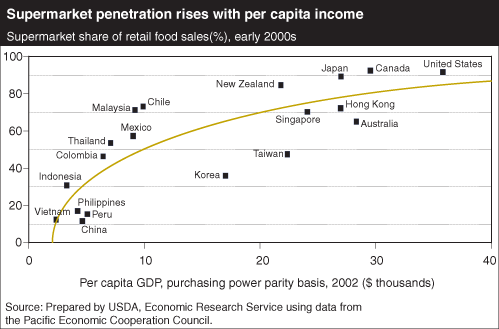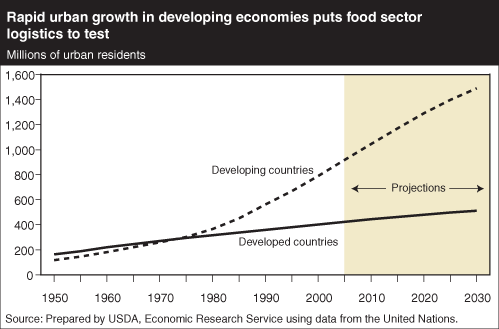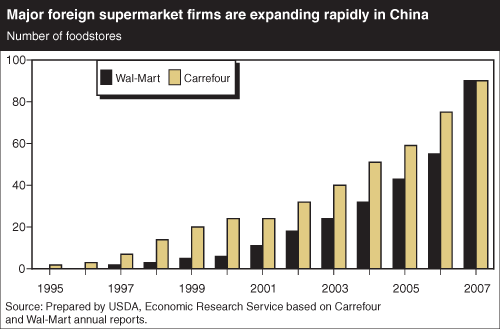A Revolution in Food Retailing Underway in the Asia-Pacific Region
- by William T. Coyle
- 6/1/2006
Highlights
- The spread of modern food chains in the Asia-Pacific region is having profound effects on consumers, food suppliers, and the broader economy.
- International supermarket chains are adding muscle to the region’s retail revolution, providing capital, technology transfer, and organizational innovation.
- Specialized suppliers are emerging to help modern supermarkets do business with small-scale producers and traditional market channels.
Rapid economic growth and urbanization are transforming the retail food sector in the developing economies of the Asia-Pacific region. At the center of this revolution is the spread of modern self-service foodstores: supermarkets, hypermarkets, discount and club stores, and chain convenience stores. Through highly efficient procurement and distribution systems, modern chain stores are able to offer consumers lower prices, greater convenience, and higher quality and safer food in increasingly complex, often congested, urban markets. They are also having profound effects on the food supply chain through their increased capacity to trade with large and distant suppliers and their ability to force domestic food producers to adapt and modernize (see box, “What Is the Pacific Economic Cooperation Council?”).
Retail food sales in the Asia-Pacific region were about $1.8 trillion in 2005, with modern supermarkets accounting for about 75 percent ($1.35 trillion) and traditional outlets accounting for the rest ($450 billion). While more than 40 percent of the region’s sales are concentrated in the U.S. and Japan, most of the growth is attributed to the region’s developing economies in China, Southeast Asia, and Mexico.
In China, the traditional food retail sector is still dominant, but supermarket store units are multiplying, and their share of total food retail sales is expected to increase from 10 to 12 percent in 2002 to 50 percent by 2012. Across Southeast Asia, supermarket sales are growing at double-digit rates. And in Mexico, supermarkets now account for more than 50 percent of retail food sales, compared with less than 5 percent in the mid-1990s.
In the developing economies of the region, supermarkets typically first appear in the biggest cities, catering to a limited number of high-income consumers. Stores then spread to smaller cities and towns, increasingly serving middle- to lower-income clientele. Initially, supermarket chains tend to specialize in easily storable packaged and processed foods, sometimes including dairy products, gradually moving into fresh fruits and vegetables, meats, and fish.
Income Growth and Urbanization Fuel Spread of Supermarkets
The remarkable rise of supermarkets in developing parts of the Asia-Pacific region is primarily fueled by rapid economic growth, which in recent years was almost twice that of the region’s developed economies and is swelling the ranks of the middle classes. China now has 200 to 300 million middle-class consumers; Mexico and Indonesia together have a middle-class population of about 70 million. Across the region, as per capita incomes approach $10,000 and a country’s middle class expands, supermarket penetration rises sharply, reaching about 50 percent. At income levels above $20,000, supermarket shares of total food retail sales level off at 70 to 90 percent.
Rapid urbanization in the region’s developing economies has also accelerated the spread of supermarkets. The Asia-Pacific region’s urban areas are expected to grow by more than half a billion people in the next 20 years, accounting for more than half of the region’s total population. The less-developed economies of the region will generate three-quarters of this growth, with urban population increases of 300 million in China, 70 million in Indonesia, and 30 million in Mexico.
Supermarkets provide a one-stop shopping experience and are more equipped to meet the needs of higher income urban consumers than traditional food retail outlets. They provide under one roof a broad variety of fresh, processed, and semi- and fully-prepared foods as well as other merchandise and services. The supply chains supporting supermarkets are also more efficient than traditional suppliers and are better able to facilitate the physical flow of food products into cities, reducing traffic congestion and adding less stress to transportation infrastructure.
Yet, despite the lure of modernity, some consumers at all income levels still prefer to shop for produce at open-air markets, where they expect to find higher quality meats and fresher fruits and vegetables. Prices of fresh fruits and vegetables tend to be lower in traditional outlets as well. But the higher produce prices in modern supermarkets are a transitory phenomenon: prices tend to drop as supermarkets continue to spread and their supply chains become more developed. For example, surveys have shown that in higher income economies such as Korea, fresh produce prices tend to be lower in supermarkets than in traditional outlets.
In the developed economies, demographic factors more than income growth affect the outlook for supermarkets. Japan’s population, for example, is aging rapidly and is beginning to shrink. Supermarket chains there face increasingly intense competition and declining profit margins. Populations in Australia, Canada, New Zealand, and the U.S. are also aging but at a slower pace than in Japan. Population growth rates in these countries are boosted by high rates of immigration and the higher fertility rates of recent immigrants. The outlook for supermarkets in these economies is more robust, but the sector will need to retool itself to serve a growing share of older and retired consumers, as well as a population grown more ethnically diverse. In the U.S., the Hispanic share of the population is expected to increase to 19 percent in 2020, up from about 13 percent in 2003. Similar shifts are expected in Australia, Canada, and New Zealand, where Asians are the fastest growing ethnic group.
Foreign Investment Drives Supermarket Expansion
Prominent international supermarket chains—Wal-Mart, Carrefour (a French company), and Tesco (from the United Kingdom)—are now heavily invested in the Asia-Pacific region and are instrumental in the region’s retail revolution, providing capital, technology transfer, and organizational innovation. Foreign companies began investing in the region fairly recently (Carrefour in Taiwan in 1989, Wal-Mart in Mexico in 1991, and Tesco in Thailand in 1998), motivated primarily by higher expected returns in the less-developed economies, where consumer incomes are rising quickly and middle classes are expanding more rapidly, than in saturated, low-margin home markets. Other factors attracting investors include lower labor costs, availability of public services, and well-developed transportation infrastructure, including roads, railroads, inland waterways, ports, and airports.
Major international chains are also motivated by the role that investment in one country can play in the company’s global system. Wal-Mart’s global purchasing office in Shenzhen, China, for example, serves not just its China operations but the company’s entire system, including its 3,700 outlets in the U.S., for which a large share of nonfood items is produced in China.
Foreign investment in the Asia-Pacific retail food sector has been facilitated by market deregulation and policy reforms implemented in many of the region’s less-developed economies over the last 15 years. In the early 1990s, for example, China began to relax restrictions on foreign direct investment in its retail sector. By 2002, China allowed up to 65 percent foreign participation in joint ventures, and it liberalized foreign investment in wholesale and logistics services. In December 2004, it committed to full liberalization of its retail sector. The response of companies such as Wal-Mart and Carrefour has been to pick up the pace of expansion. Wal-Mart plans to have a total of 90 outlets in China by the beginning of 2007, up from 47 as of July 2005, and Carrefour expects to open 15 hypermarkets (stores with a sales area of over 2,500 square meters—26,910 square feet—with at least 35 percent of selling space devoted to nonfoods) a year in the next several years.
Foreign firms expanded investments in Indonesia in 1998 after that country lifted restrictions on wholesale and retail trade during the 1997-99 Asian financial crisis. At that time, some foreign investors were attracted to the cheaper asset prices and construction costs afforded by their stronger currencies. While foreign investment regulations in Indonesia were largely eased in the late 1990s, some restrictions remained. For example, both domestic and foreign modern-format foodstores are required to locate at specific distances from traditional outlets, with the distances determined by each store’s floor size. Restrictions are more severe outside provincial capitals. Even so, foreign firms such as Carrefour and Makro are expanding rapidly in Indonesia: from 2004 to 2005, these two firms increased their number of outlets by 25 percent.
Other Asia-Pacific economies also liberalized their markets in the 1990s. South Korea and Vietnam lifted restrictions in 1996, allowing foreign joint ventures in supermarkets for the first time.
Foreign investment in the retail food sector is not always a cakewalk. Some international chains face intense competition from national retailers. Ito-Yokado in Japan, Matahari in Indonesia, E-Mart in South Korea, and Lianhua in China have fared well against foreign competition. Some foreign companies have pulled back investments in Asia and Latin America. In March 2005, Carrefour announced the sale of eight stores in Japan to Aeon Co., a major Japanese retail chain. It also sold all of its assets in Mexico, which included 29 operating hypermarkets plus two due to open in 2005, to the Chedraui Group, a leading Mexican retailer. Wal-Mart faces the challenges of rehabilitating its Japanese affiliate, Seiyu Ltd., and is rethinking its low-price strategy in an effort to appeal to Japan’s more status-conscious consumers.
Centralized Procurement and Distribution Lowers Costs of Supermarkets . . .
Once supermarket chains have more than 10 outlets in a particular geographic area, they tend to take more control over procurement and distribution functions by investing in centralized warehousing and distribution centers. While such a move might raise transportation costs in some cases, it nevertheless lowers overall costs by reducing handling, delivery times, and, in the case of fresh produce, shrinkage (loss of weight or volume). Centralized functions also increase in-store and head-office productivity, and, through the application of information technology, enable stores to improve sales monitoring and inventory management. Centralization also allows supermarkets to add products and services to meet the demands of consumers and to spread risk over a larger product portfolio. This diffusion of risk allows companies to pursue different pricing strategies, including deep discounts on some food items, to attract customers. For some companies in China, centralized procurement and distribution is cutting logistics costs by as much as 30 to 40 percent.
While most small and medium-sized chains in the Asia-Pacific region still procure goods on a store-by-store basis from wholesale markets and dedicated wholesalers, some have opened distribution centers. Others are forming joint ventures and/or participating in collective arrangements with other companies to procure and distribute both dry goods and fresh produce.
. . .and Broadens Their Geographical Reach
Centralized procurement and distribution functions broaden the geographic reach of a firm’s business to include more distant regional and national suppliers, displacing traditional, localized channels in the process. Distribution centers’ use of standardized equipment and organizational systems—such as shipping containers, tractor trailers, pallets, forklifts, and bar-code readers and computerized inventory management systems—facilitates domestic and international transactions with large suppliers and other distribution centers. Modernization of port facilities, a priority in many Asia-Pacific developing countries, may also facilitate a supermarket chain’s ties with foreign suppliers, making it less expensive to buy food products from distant foreign sources than from nearby domestic producers, who may be handicapped by lack of scale or by inadequate refrigeration and transportation infrastructure.
Wal-Mart’s distribution center in Mexico, for example, procures avocados not only for its Mexican stores but also for shipment to distribution centers in other countries, including China. The big European chains Metro and Auchan procure exotic vegetables for sale in their stores in Chengdu, China, from their Shanghai headquarters, more than 1,200 miles away. The compatibility of Carrefour’s procurement and distribution operations across countries facilitates the procurement of nonfood products in China, where it is the leading foreign supermarket chain, for sale in its Indonesian hypermarkets.
Despite such trends, most processed food products sold by supermarket chains in the Asia-Pacific region’s low-income countries are still processed nationally, using either domestic and/or imported raw materials. According to ERS research, food manufacturers of highly processed products generally prefer to locate production facilities close to the point of consumption. On a global basis, imports account for only 6 percent of processed food sales, compared with 16 percent of sales of major bulk agricultural commodities.
Supermarkets are most likely to sell imported products they cannot procure nationally. These may include out-of-season or tropical fresh fruits and vegetables; livestock products whose production requires forage area and grain supplies typically found in a few land-extensive economies, such as the U.S., Australia, Canada, and New Zealand; and highly processed products with an exotic appeal, like French wines and Dutch cheeses.
A Force for Modernization: Specialized Suppliers
In response to the centralization of supermarket procurement in developing Asia-Pacific economies, specialized suppliers are emerging to provide modern food retailers with larger product volumes at lower cost. These suppliers are more responsive to supermarket demands for higher and more consistent quality, steady supplies, and product innovation (see box, “Specialized Suppliers Respond to the Revolution in Food Retailing”).
This restructuring has happened most rapidly with dry goods and processed and semi-processed foods, but it is also affecting fresh produce, which tends to lag other categories.In all less-developed economies, there exists a technologically advanced and competitive segment of the food sector. This sector is well adapted to modern supermarkets and centralized procurement systems, including those of large multinational food companies operating in the region, like Nestlé, the Lotte Group, and Unilever
Modern supermarkets naturally favor these suppliers. But in a developing economy, a significant share of food supplies still must come from the traditional sector, which tends to be fragmented and often burdened by inadequate transportation and cold storage infrastructure.
Specialized suppliers are developing and adapting to help modern supermarkets do business with small-scale producers and traditional market channels. These suppliers assume responsibility for collecting production, packaging, assuring steady supply, and, in some cases, meeting traceability objectives.
Specialized suppliers are also held accountable for product quality, consistency, and food safety—factors that strongly influence a supermarket’s business reputation. A supermarket must choose its suppliers carefully because lapses in quality or food safety, even if it originates from a link elsewhere in the food supply chain, tend to be associated with the supermarket itself. Consumers might react to negative information about a supermarket by avoiding not just the outlet in which the incident occurred, but all of a chain’s outlets. Such a reaction could have significant short- and longer-term consequences on firm revenues.
Government Too Has a Role in the Retail Food Revolution
The growth of supermarkets is a significant economic force in developing economies of the Asia-Pacific region. Supermarket expansion is contributing to lower food costs, higher food quality and safety standards, and a modernized food system. Lower food prices help sustain economic development—consumers spend less on food and more on nonfood items, thus providing a stimulus to other economic sectors. Enhanced food supply chains help modern supermarkets overcome the logistical challenges inherent in areas undergoing rapid urbanization.
The shift to modern food retailing has no singular path. Some markets combine larger scale retailers, such as hypermarkets selling food and nonfood items, with small-scale neighborhood shops. The corporate focus ranges from large multinational chains to companies that focus more narrowly on a single city or region within an economy.
Specialized suppliers are emerging as transitional change agents, enhancing the best that traditional small-scale producers and markets now offer. At the same time, these suppliers are promoting upgrades to their operations by adopting better and safer production and marketing practices, as well as modern technologies.
Many of these changes are occurring without direct government aid. But policymakers can have a direct role in the modernization of the retail food sector. Government investment in expanding and upgrading transportation infrastructure improves access to distant locales or food surplus areas and enhances the flow of products to urban food distribution systems. The reduction or elimination of investment barriers creates opportunities for foreign investment to modernize existing retail outlets and build new outlets and the supply chains to support them.
Governments can also help by lowering trade barriers, thus making it easier for food retailers and processors to acquire food products with desired characteristics from sources offering those products at the lowest price. This policy intervention may open new markets to producers able to meet market demands and keeps consumer food costs low.
The growth of supermarkets—largely the result of private industry and consumer actions—presents significant economic opportunities for developing countries in the region. Government efforts to temper this expansion would be difficult if not impossible. A more favorable action by policymakers may be to assess resources and policy options that help the traditional sector adapt to a modernizing food system.
This article is drawn from:
- Coyle, W.T. (2005, September 1). Asia-Pacific Transportation Infrastructure: Linking Food Sources to Urban CentersUrban Centers. Amber Waves, U.S. Department of Agriculture, Economic Research Service.
- Pacific Food System Outlook 2005-06: A Revolution in Food Retailing. (2005). Pacific Economic Cooperation Council.
- The Emergence of Supermarkets with Chinese Characteristics: Challenges and Opportunities for China’s Agricultural Development. (2004). Development Policy Review.
- Supermarketization of the Emerging Markets of the Pacific Rim: Development and Trade Implications. (2005). Journal of Food Distribution Research. 36 (1)..
You may also like:
- China. (n.d.). U.S. Department of Agriculture, Economic Research Service.




